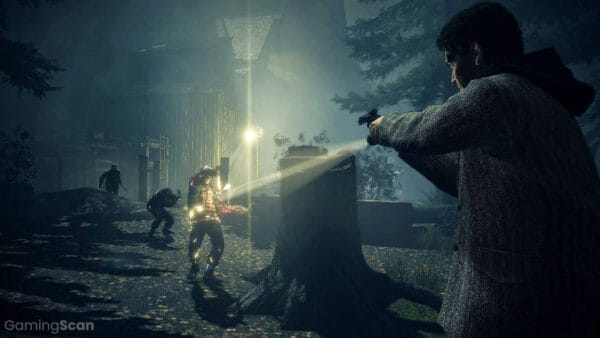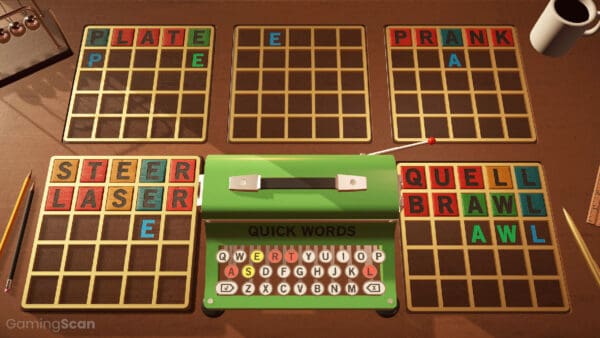When talking about the best horror games of all time, you’re bound to see some familiar titles brought up: Resident Evil, Amnesia, Outlast, among a number of others. However, there is one game that might be overlooked on that list, and that would be F.E.A.R., or “F.E.A.R. First Encounter Assault Recon”, if we were to use the full title.
The original F.E.A.R. was quite something back in 2005 and while it took the 2000s by storm and carried a lot of potential, the series sadly fizzled out less than a decade later after two somewhat underwhelming sequels.
If you’ve never played any of the F.E.A.R. games yet, read on, as we’ll go over all of them in this article, providing a brief overview of each one.
Table of ContentsShow

F.E.A.R. First Encounter Assault Recon
Release date: October 17, 2005
Developer: Monolith Productions
Platforms: Microsoft Windows, Xbox 360, PlayStation 3
Starting with the first and best game that kicked off the franchise, F.E.A.R. was a game that got so many things right, from the gunplay to the horror elements, and it was very impressive from a technical standpoint, too, as the graphics were quite a sight to behold back in 2005 – provided that you had a PC that could run the game at maximum settings, that is.
As far as the gameplay is concerned, F.E.A.R. is a first-person shooter, and a very good one at that. While the mechanics aren’t exactly complex, the game’s fast-paced, visceral action made the shootouts extremely engaging. In between the great environment design, excellent enemy AI, and a “reflex time” (bullet time) mechanic, F.E.A.R. is an exhilarating experience from start to finish.
But of course, the combat isn’t the only thing that kept the players on the edges of their seats throughout the campaign. The game’s levels are essentially split into action and exploration segments. As you might expect, the action segments are focused on the player taking down squads of hostile Replica soldiers, while the exploration segments were there to provide a change of pace and focus on the game’s horror aspect and the story.

Namely, while the player could explore the levels in search of upgrades, new weapons, and story-related intel collectibles, they’d have the series’ signature antagonist – the ghostly girl known as Alma – keeping them company. Her presence would be announced by the HUD flickering, and from that point onward, the player could expect to encounter various anomalies and hallucinations that sometimes provided insight into the game’s story, in addition to making the player jump back in their seat.
All in all, while F.E.A.R.’s horror elements aren’t quite as effective today as they were back in 2005, they still hold up fairly well, and so does the action. As a matter of fact, we’d say that F.E.A.R.’s action segments are as good, if not better than those that you’d see in some of the modern action games.
As mentioned before, the AI is great, and it makes you feel as if you were going up against a squad of trained soldiers rather than moving bullet sponges with guns. Moreover, the gun handling and the environmental effects are both very effective at bringing the experience to life.

Now, F.E.A.R. also received two expansions: Extraction Point and Perseus Mandate, both of which were developed by TimeGate Studios rather than Monolith.
Extraction Point came out in 2006 and it is the better expansion of the two, as it closely follows the formula and mood of the base game. It added a new single-player campaign, a couple of new weapons, and some new enemy types. All in all, it was a solid expansion that’s worth playing, though it’s a bit lacking compared to the base game, especially in the story department.
Next, Perseus Mandate followed in 2007, and it is sadly one of the weakest points in the franchise’s history. While it kept the new additions introduced in Extraction Point and added some of its own, the expansion’s graphics and level design were both lacking, not to mention that the horror segments largely devolved into uninspired, repetitive jumpscares.
So, all in all, F.E.A.R. is definitely a game worth trying out even in 2023 if you haven’t played it already, and the first expansion is also worth playing if you like the base game, although the second one is a mixed bag.

F.E.A.R. 2: Project Origin
Release date: February 10, 2009
Developer: Monolith Productions
Platforms: Microsoft Windows, Xbox 360, PlayStation 3
The proper sequel to F.E.A.R. came out in 2009 and while it could more than stand on its own two legs, it started pushing the series in a new direction that didn’t really sit well with the fans of the original game. F.E.A.R. 2: Project Origin followed the same core formula that the first game revolved around – semi-linear levels broken up into action and exploration segments – but it added some new tweaks.
In addition to a more diverse cast of enemies (an area where the original was lacking), F.E.A.R. 2 also added the option for players to tip over environment objects to create cover, thus making arenas a bit more dynamic. The game also featured some vehicle combat i.e. combat mech segments that provided a nice change of pace to the usual FPS/horror action.
Overall, though, F.E.A.R. 2 was adapting to a changing market and trying to appeal more to a console audience, in stark contrast to the original F.E.A.R., which was developed and released for PC first, and this reflects on the game in a number of ways.
For example, one of the minor but notable new additions are the iron sights, and it might not seem like a big deal at first. However, in practice, being encouraged to aim down the sights instead of hip-firing like in the first game ultimately slowed the action down and took away from that tense, cinematic firefight experience that made the shootouts in the first game so effective.

Then, there are the horror segments that rely mostly on scripted jumpscares, often with little lead-up, something that ultimately makes them come across as quite cheap. Granted, the first game also had its own share of those, but the original’s dark and gritty levels helped bolster the atmosphere, the scares usually had a proper build-up leading up to them, and the overall tone of the game simply fit better.
In contrast, the aesthetic of F.E.A.R. 2, replete with particle effects and saturated colors, as well as the presence of plenty of talkative NPCs, don’t quite achieve the same effect as the bleak, claustrophobic, and lonely environments of the original do.
The game also received a single DLC titled F.E.A.R. 2: Reborn that added several more missions but no major new features, and apart from adding some more content to burn through, its purpose was to set up the story for the sequel.
Ultimately, while we’d say that F.E.A.R. 2: Project Origin is a solid game that has its own merits, it sadly fades in comparison to the original on virtually every front. While the first game has its own distinct identity, the sequel looks more like your run-of-the-mill console shooter from the late 2000s/early 2010s at first glance, and it plays that way, too.

F.E.A.R. 3
Release date: June 21, 2011
Developer: Day 1 Studios
Platforms: Microsoft Windows, Xbox 360, PlayStation 3
The third and final mainline entry came in 2011 in the form of F.E.A.R. 3, a game that you likely wouldn’t even be able to identify as F.E.A.R. at all if it weren’t for the logo and some familiar names.
We’ve mentioned that the second game started focusing more on the console market, and the third one went all the way down that road. Namely, the game featured a cover system that would snap the player to third-person and allow them to have a better view of their surroundings, all the while also limiting them to carrying only two weapons at a time.
In addition to that, the game also put a lot of stock into co-op play, which was a leading trend in the early 2010s. The entire campaign can be played through in co-op and, in fact, F.E.A.R. 3 generally fares better when experienced through co-op rather than single-player.

So, while it is a decent enough shooter in its own right, F.E.A.R. 3 is simply not a F.E.A.R. game, at least not in any way that counts. If you were to strip away all the familiar names and likenesses from the first game, you’d be left with a largely generic cover shooter that would be difficult to distinguish in the sea of other similar games that were released around that same time.
Ultimately, as we’ve said above, F.E.A.R. 3 isn’t terrible when viewed in isolation, but it is terrible if we view it as a continuation of the F.E.A.R. series, as it completely fails on the horror front and the atmosphere is pretty much non-existent. As such, we’d say that it is only really worth playing if you have a friend who’d be willing to give co-op a try, as that is the game’s biggest strength.

F.E.A.R. Online
Release date: October 8, 2014
Developer: Aeria Games
Platform: Microsoft Windows
The last F.E.A.R. game (for the time being) was F.E.A.R. Online, a short-lived multiplayer game developed by Aeria Games. After several months in closed beta, an open beta version of the game was released on Steam in October 2014, only to be shut down roughly half a year later in May 2015.
The game featured a co-op mode modeled largely after that of Left 4 Dead, with four players making their way through a campaign that’s split into multiple episodes. On top of that, it also featured a couple of PvP modes, but as mentioned above, the final game never ended up seeing the light of day.
Conclusion
And so, that would be it – all the F.E.A.R. games released so far!
As mentioned in the introduction, the franchise started off strong, only to slowly sink into obscurity a few years later. Ultimately, a mix of different factors led to the untimely downfall of what was shaping up to be a promising series, and the changing market contributed greatly to that.
The question of whether we’ll ever see a proper new F.E.A.R. game remains unanswered so far. It’s not impossible that a reboot or a remake could one day be released, capitalizing on what made the original so good in the first place.
However, the prospects aren’t looking great at the moment, as there has been no word on any new F.E.A.R. projects in years, so the hopeful fans can only hope.



